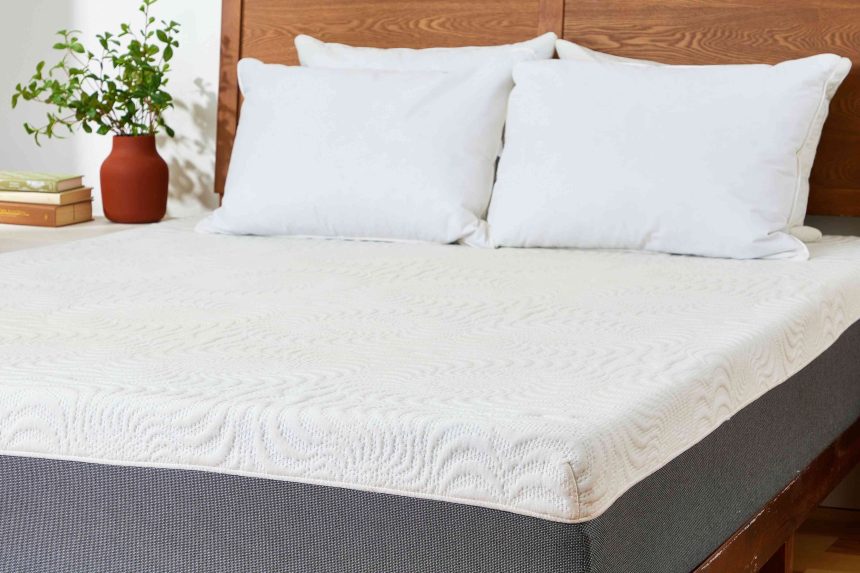Shopping for mattresses and bedding used to be a decision that came down to the size of your bed. Now, there are so many more options when it comes to the kinds of materials your mattress, pillows, and mattress toppers can be made out of—not to mention the ways in which these mattresses are shipped in boxes or picked up in stores.
This article takes a closer look at a popular mattress material: memory foam. Experts weigh in on how it works and stacks up to other materials.
- Scott Peterson is senior vice president of product management at Yogasleep.
- Marten Carlson is a mattress expert and lead mattress reviewer at Mattress Clarity.
- Dr. Sham Singh is a sleep expert and psychiatrist at WINIT Clinic.
“Memory foam is a popular bedding material known for its comfort and ability to contour to your body. It’s made from a type of soft, supportive foam that reacts to heat and pressure, which is why it feels like it’s hugging you when you lie down,” says Scott Peterson, senior vice president of product management at Yogasleep. “This feature makes it great for relieving pressure points and providing personalized support.”
What Is Memory Foam?
Memory foam is a commercial name for a type of foam NASA scientists developed to protect astronauts in flight. The material was first used in mattresses in the 1990s.
“Memory foam in mattresses is made of viscoelastic polyurethane foam, which is made with chemicals to increase its viscosity and density,” explains Marten Carlson, a mattress expert and lead mattress reviewer at Mattress Clarity. “Unlike regular foam, memory foam has a slow response time and molds to the shape of your body when pressure is applied. This differs from traditional foam, which bounces back quickly and doesn’t offer the same level of body contouring.”
Other materials, such as latex, don’t mold to the body the same way and are considered more resilient than memory foam, Carlson explains.
Memory foam is a top pick for many sleepers because it offers a sort of custom sleep solution.
“When you lie down, the foam reacts to your body temperature and pressure, softening and molding to your shape,” Carlson says. “This creates a cradling effect that supports your body and helps evenly distribute your weight. The result is less pressure on sensitive areas like your hips and shoulders, which can improve comfort, reduce tossing and turning, and support spinal alignment.”
Bedding Comparisons
How does memory foam compare to other types of mattress materials? Latex offers a level of body molding, Carlson explains, but other options, such as traditional innerspring mattresses, don’t offer the body-hugging effect. Instead, spring mattresses offer more bounce.
“Hybrid options have both memory foam and innerspring coils,” Carlson says. “The foam helps with pressure relief, and the coils add support and airflow to help keep you cooler.”
Memory foam is ideal for sleepers with back or joint pain, says Dr. Sham Singh, a sleep expert and psychiatrist at WINIT Clinic. “Because memory foam responds slowly rather than springing back immediately, it minimizes motion transfer, hence being helpful for any person who shares a bed,” Singh adds.
Like any mattress type or material, memory foam comes with its pros and cons.
Pros of Memory Foam
Supports All Sleepers
Sleepers with all different preferences can find a memory foam that works for them.
“I have found that side sleepers love memory foam for its great ability to cradle the hips and shoulders, relieving pressure in these areas,” Singh says. “Back sleepers can also find relief from the lumbar support provided by memory foam, while stomach sleepers might prefer a firmer foam so they don’t sink too deeply.”
Isolates Motion
If you sleep with a partner, Peterson says memory foam is a good material to choose. “In mattresses, memory foam stands out for its motion isolation—it absorbs movement, so if your partner tosses and turns, you’re less likely to be disturbed,” he says.
More Affordable Than Latex or Down
“Memory foam is usually cheaper than latex or down, but higher-quality memory foam can get pricey,” Carlson says. “It’s usually more affordable than a high-end innerspring mattress.”
Cons of Memory Foam
Flattens Over Time
Like all mattresses, memory foam loses its structure over time, sagging in areas where you sleep most of the time.
To avoid this, Peterson suggests investing in high-quality memory foam products with good density ratings of 4 to 5 pounds per cubic foot for mattresses. “Rotating the mattress regularly can also help distribute wear evenly,” he adds.
Retains Heat
“Traditional memory foam can trap body heat, which might make some people feel too warm during the night,” Peterson says. “This happens because of its dense structure, which doesn’t allow for much airflow.”
You can mitigate some of the heat by looking for mattresses or toppers with cooling technologies, such as gel-infused foam, open-cell structures, or copper infusions, Peterson says.
Emits Chemical Smell When New
“New memory foam products can emit a chemical smell because of the materials used in manufacturing,” Carlson says. “Allow the mattress or pillow to air out in a well-ventilated room before use.” Typically, the smell goes away quickly.
“Let the product air out in a well-ventilated room for a few days before use,” agrees Peterson. “Look for certifications like CertiPUR-US, OEKO-TEX, or GREENGUARD Gold, which verify low VOC emissions.”
Choosing a Mattress Type
Choosing an option like memory foam for your mattress, pillows, or mattress topper comes down to personal preference. Many types of sleepers enjoy memory foam. Carlson says memory foam is a good choice for side sleepers because it contours to offer relief at the hips and shoulders.
- Carlson suggests medium to soft firmness for side sleepers.
- Back sleepers will prefer medium to medium-firm memory foam, which Carlson explains offers spinal support.
- Stomach sleepers will likely prefer firmer foam to prevent sinking into the mattress and adding strain to the neck and lower back, Carlson says.
More Mattress Specifics
If you’ve decided to choose a memory foam mattress, you’ll also need to decide on specifics as you consider density, thickness and certifications.
“Higher-density foam (4-5 pounds per cubic foot) tends to offer better durability and support, though it may sleep warmer,” Carlson says. “A thicker layer of memory foam can improve comfort, but, if it’s too thick, it can cause overheating and provide less bounce. Aim for at least 3 inches for a mattress topper.”
If you tend to overheat when you sleep, Singh suggests looking for a memory foam designed to sleep cool. These include foams with a gel or breathable design. “But at the bottom line, it is about personal preference for firmness, and testing the product is quite important when feasible,” he adds.
Finally, you can look for certifications like CertiPUR-US, which guarantees the foam is free from harmful chemicals and meets safety and environmental standards, Carlson adds.








